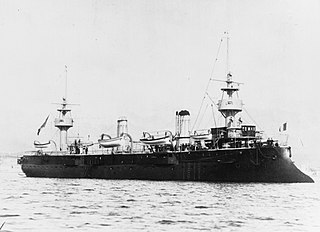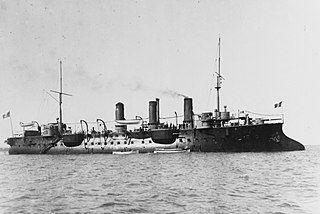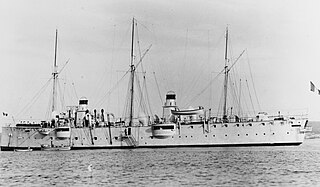
D'Estrées was the lead ship of her class of protected cruisers built for the French Navy in the late 1890s. The class was ordered as part of a construction program directed at strengthening the fleet's cruiser force at a time the country was concerned with the growing naval threat of the Italian and German fleets, and were intended to serve overseas in the French colonial empire. D'Estrées was armed with a main battery of two 138 mm (5.4 in) guns, was protected by an armor deck that was 38 to 43 mm thick, and was capable of steaming at a top speed of up to 20 to 20.5 knots.

Troude was a protected cruiser of the French Navy, the lead ship of the Troude class. The class was built as part of a construction program intended to provide scouts for the main battle fleet. They were based on the preceding Forbin class, the primary improvement being the addition of armor to the conning tower. Troude was built in the 1880s and was completed in late 1890. She was armed with a main battery of four 138 mm (5.4 in) guns, protected with an armor deck that was 41 mm (1.6 in) thick, and had a top speed of 20.5 knots.

The Friant class comprised three protected cruisers of the French Navy built in the early 1890s; the three ships were Friant, Bugeaud, and Chasseloup-Laubat. They were ordered as part of a naval construction program directed at France's rivals, Italy and Germany, particularly after Italy made progress in modernizing its own fleet. The plan was also intended to remedy a deficiency in cruisers that had been revealed during training exercises in the 1880s. As such, the Friant-class cruisers were intended to operate as fleet scouts and in the French colonial empire. The ships were armed with a main battery of six 164 mm (6.5 in) guns supported by four 100 mm (3.9 in) guns and they had a top speed of 18.7 knots.

The Jean Bart class comprised two protected cruisers of the French Navy built in the late 1880s and early 1890s; the two ships were Jean Bart and Isly. They were ordered as part of a fleet program that accorded with the theories of the Jeune École, which proposed a fleet based on cruisers and torpedo boats to defend France. The Jean Bart-class cruisers were intended to serve a long-range commerce raiders to attack enemy merchant shipping. The ships were armed with a main battery of four 164 mm (6.5 in) guns supported by six 138 mm (5.4 in) guns and they had a top speed of 19 to 19.5 knots.

The Forbin class was a group of three protected cruisers built for the French Navy in the late 1880s and early 1890s. The class comprised Forbin, Coëtlogon, and Surcouf. They were ordered as part of a fleet program that, in accordance with the theories of the Jeune École, proposed a fleet based on cruisers and torpedo boats to defend France. The Forbin-class cruisers were intended to serve as flotilla leaders for the torpedo boats, and they were armed with a main battery of four 138 mm (5.4 in) guns.

Tage was a protected cruiser built for the French Navy in the 1880s, the second vessel of that type built for the French fleet. The design was based on the previous cruiser, Sfax, and like that vessel, Tage was intended to be used as a commerce raider to attack merchant shipping. As such, she carried a barque sailing rig to supplement her steam engines for long voyages overseas. Tage was armed with a main battery of eight 164 mm (6.5 in) guns and had a curved armor deck that was 51 to 56 mm thick.

Suchet was a protected cruiser of the French Navy built in the late 1880s and early 1890s. The ship was ordered during the tenure of Admiral Théophile Aube as the French Minister of Marine, who favored a fleet centered on large numbers of cruisers of various types. Suchet and the similar vessel Davout were ordered to fill the role of a medium cruiser in Aube's plans; the two cruisers were meant to be identical, but problems during Davout's construction forced design changes to Suchet, resulting in two unique vessels rather than a single class. Suchet was armed with a main battery of six 164 mm (6.5 in) guns in individual mounts and had a top speed of 20.4 knots.

Forbin was a protected cruiser, the lead ship of the Forbin class, built in the late 1880s for the French Navy. The class was built as part of a construction program intended to provide scouts for the main battle fleet. They were based on the earlier unprotected cruiser Milan, with the addition of an armor deck to improve their usefulness in battle. They had a high top speed for the time, at around 20 knots, and they carried a main battery of four 138 mm (5.4 in) guns.

Surcouf was the second Forbin-class protected cruiser built for the French Navy in the late 1880s and early 1890s. The Forbin-class cruisers were built as part of a construction program intended to provide scouts for the main battle fleet. They were based on the earlier unprotected cruiser Milan, with the addition of an armor deck to improve their usefulness in battle. They had a high top speed for the time, at around 20 knots, and they carried a main battery of four 138 mm (5.4 in) guns.

Lalande was a protected cruiser of the Troude class built for the French Navy in the late 1880s and early 1890s. The class was built as part of a construction program intended to provide scouts for the main battle fleet. They were based on the preceding Forbin class, the primary improvement being the addition of armor to the conning tower. Lalande was built in the 1880s and was completed in late 1890. She was armed with a main battery of four 138 mm (5.4 in) guns, protected with an armor deck that was 41 mm (1.6 in) thick, and had a top speed of 20.5 knots.

Cosmao was the third and final member of the Troude class of protected cruisers built for the French Navy in the late 1880s and early 1890s. The class was built as part of a construction program intended to provide scouts for the main battle fleet. They were based on the preceding Forbin class, the primary improvement being the addition of armor to the conning tower. Cosmao was built in the 1880s and was completed in 1890. She was armed with a main battery of four 138 mm (5.4 in) guns, protected with an armor deck that was 41 mm (1.6 in) thick, and had a top speed of 20.5 knots.

Isly was a Jean Bart-class protected cruiser built in the late 1880s and early 1890s for the French Navy. The second and final member of the class, Isly and her sister ship were ordered during the tenure of Admiral Théophile Aube as Minister of Marine according to the theories of the Jeune École doctrine. The ships were intended as long-range commerce raiders, and they were armed with a main battery of four 164 mm (6.5 in) guns, were protected by an armor deck that was 50 to 100 mm thick, and were capable of steaming at a top speed of around 19 knots.

Friant was a protected cruiser of the French Navy built in the 1890s, and the lead ship of the Friant class. Friant and her two sister ships were ordered as part of a major construction program directed against France's Italian and German opponents in the Triple Alliance, and they were intended to serve with the main fleet, and overseas in the French colonial empire. They were armed with a main battery of six 164 mm (6.5 in) guns and had a top speed of 18.7 knots.

Bugeaud[by.ɡo] was a Friant-class protected cruiser of the French Navy built in the 1890s, the second of three ships of the class. The Friant-class cruisers were ordered as part of a construction program directed at strengthening the fleet's cruiser force. At the time, France was concerned with the growing naval threat of the Italian and German fleets, and the new cruisers were intended to serve with the main fleet, and overseas in the French colonial empire. Bugeaud and her two sister ships were armed with a main battery of six 164 mm (6.5 in) guns, were protected by an armor deck that was 30 to 80 mm thick, and were capable of steaming at a top speed of 18.7 knots.

Chasseloup-Laubat was a protected cruiser of the Friant class built in the 1890s for the French Navy, the last of three ships of the class. The Friant-class cruisers were ordered as part of a construction program directed at strengthening the fleet's cruiser force. At the time, France was concerned with the growing naval threat of the Italian and German fleets, and the new cruisers were intended to serve with the main fleet, and overseas in the French colonial empire. Chasseloup-Laubat and her two sister ships were armed with a main battery of six 164 mm (6.5 in) guns, were protected by an armor deck that was 30 to 80 mm thick, and were capable of steaming at a top speed of 18.7 knots.

Descartes was the lead ship of the Descartes class of protected cruisers built for the French Navy in the 1890s. The Descartes-class cruisers were ordered as part of a construction program directed at strengthening the fleet's cruiser force. At the time, France was concerned with the growing naval threat of the Italian and German fleets, and the new cruisers were intended to serve with the main fleet, and overseas in the French colonial empire. Descartes was armed with a main battery of four 164.7 mm (6.5 in) guns, was protected by an armor deck that was 20 to 40 mm thick, and was capable of steaming at a top speed of 19 knots.

Catinat was the lead ship of the Catinat class of protected cruisers built for the French Navy in the 1890s. The Catinat-class cruisers were ordered as part of a construction program directed at strengthening the fleet's cruiser force at a time the country was concerned with the growing naval threat of the Italian and German fleets. The new cruisers were intended to serve with the main fleet and overseas in the French colonial empire. Catinat was armed with a main battery of four 164 mm (6.5 in) guns, was protected by an armor deck that was 25 to 60 mm thick, and was capable of steaming at a top speed of up to 20 knots.

Protet was a protected cruiser of the French Navy built in the 1890s, the second and final member of the Catinat class. The Catinat-class cruisers were ordered as part of a construction program directed at strengthening the fleet's cruiser force at a time when the country was concerned with the growing naval threat of the Italian and German fleets. The new cruisers were intended to serve with the main fleet and overseas in the French colonial empire. Protet was armed with a main battery of four 164 mm (6.5 in) guns, was protected by an armor deck that was 25 to 60 mm thick, and was capable of steaming at a top speed of up to 20 knots.

Infernet was the second and final member of the D'Estrées class of protected cruisers built for the French Navy in the 1890s. The D'Estrées-class cruisers were ordered as part of a construction program directed at strengthening the fleet's cruiser force at a time the country was concerned with the growing naval threat of the Italian and German fleets. The new cruisers were intended to serve overseas in the French colonial empire. D'Estrées was armed with a main battery of two 138 mm (5.4 in) guns, was protected by an armor deck that was 38 to 43 mm thick, and was capable of steaming at a top speed of up to 20 to 20.5 knots.


















